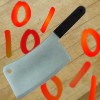
I remember, about 35 years ago working on an autopilot for my Dads boat, using a simple 2 transistor switching circuit, it was too sensitive and responded to touch, cured it with proper biasing resistor. BTW I was not grounded. You could put a groundplane and sense wire together coaxially or using spiral technique.
Last edited by Archangel; - 18th October 2013 at 18:40.
Reason: remove html
If you do not believe in MAGIC, Consider how currency has value simply by printing it, and is then traded for real assets.
.
Gold is the money of kings, silver is the money of gentlemen, barter is the money of peasants - but debt is the money of slaves
.
There simply is no "Happy Spam" If you do it you will disappear from this forum.






 then buy the chip.
then buy the chip.










Bookmarks